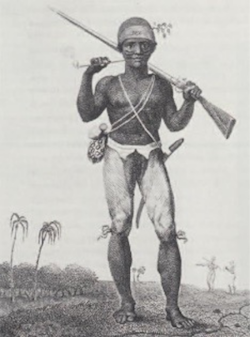
Maroon was the name given to escaped African slaves and their descendants in the Caribbean. A large community began to flourish on the island of Jamaica, which was ruled by the Spanish at the time, from 1530 onwards after several slave revolts in the colonies of New Spain. The Spanish called them maroons, which is believed to come from the word ‘cimarron’, meaning ‘fierce’ or ‘unruly’. They were known to often ally themselves with buccaneers.
In 1655 the British conquered much of Jamaica and many slaves took advantage of the opportunity to join the maroon communities in the hills. At first, they fought the British, but later allied themselves with them against the Spanish under their leader Lubolo, finally driving the Spanish from the island in 1660. When Lubolo was later killed by another maroon leader called Juan de Serras in 1663, a war lasting decades broke out.
The British were unable to dislodge the maroons from their bases in the mountains, and in 1720 the maroons went on the offensive, attacking plantations. By that time, the maroons were divided into two factions, the Windward and Leeward maroons. Between 1729 and 1739 open warfare was waged between them and the British, but the guerilla tactics of the ex-slaves was too much for the British governor, Robert Hunter, and his troops, and after his death the new Jamaican government resorted to a combination of negotiations and the tactic of divide and conquer.
The war ended with a treaty in 1739, although slavery in the Caribbean continued for another century. Ironically, the maroons were obligated under the treaty to return runaway slaves to their owners. It wasn’t until a massive slave revolt in 1831 that slavery was finally abolished throughout the British Caribbean.
For more information on the maroons of Jamaica read the article Guerilla Warfare in Eighteenth Century Jamaica on the Penmuseum website. For more information on slave resistance check out the site Slave Resistance – A Caribbean Study.
Below is an interesting video on the topic by the Youtube channel History Dose.
